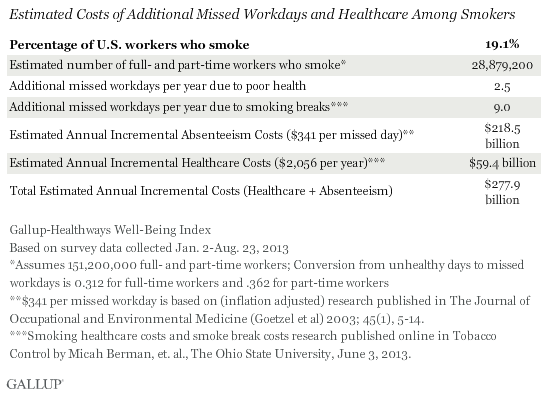WASHINGTON, D.C. -- Workers who smoke cost the U.S. economy an estimated $278 billion annually in lost productivity due to absenteeism and extra healthcare costs. This figure is based on an analysis of the cost of extra missed workdays due to poor health, partial absenteeism due to smoke breaks, and additional healthcare costs compared with workers who do not smoke.

These findings are based on more than 67,000 interviews conducted as part of the Gallup-Healthways Well-Being Index from Jan. 2-Aug. 21, 2013, with American adults who work at least one hour or more per week.
Gallup calculated unhealthy days using respondents' answers to the question, "During the past 30 days, for about how many days did poor health keep you from doing your usual activities?" and "How many actual workdays in the last month did you not work due to poor health?"
In the U.S., 19.1% of workers smoke, slightly lower than the 20.3% of all American adults -- working or not -- who smoke. These individuals report more than seven additional unhealthy days and about 2.5 additional missed workdays each year compared with their counterparts who do not smoke, after controlling for age, gender, race/ethnicity, household income, education, marital status, and region.
Across all workers, the estimated cost of absenteeism to their respective employers is $341 per complete missed workday. Additionally, partial-day absenteeism due to recurring smoke breaks cost an estimated $13 per workday, accumulating to an additional $3,077 per year per worker. Healthcare costs for smokers are about $2,056 per year more than the costs for nonsmokers.
Implications
Smoking continues to consistently account for nearly 450,000 premature deaths in the U.S. each year, even as concerns about obesity have soared past those about smoking. Smoking rates among U.S. adults dropped steadily from highs of around 45% in 1950 to 22% in 2005. Since that time, however, the decline in smoking has abated, with the national smoking rate staying in the 20% to 21% range consistently since Gallup and Healthways initiated the Well-Being Index in in 2008. The percentage of workers who smoke has consistently hovered just slightly below the overall rate.
As employers increasingly engage in improving the health of their workers, smoking cessation programs continue to represent a substantial means of reducing healthcare costs and absenteeism. Although other well-being-based programs can and should be embraced, the critical issue of reducing smoking in the workforce endures as a high return on investment for employers.
About the Gallup-Healthways Well-Being Index
The Gallup-Healthways Well-Being Index tracks well-being in the U.S. and provides best-in-class solutions for a healthier world. To learn more, please visit well-beingindex.com.
Survey Methods
Results are based on telephone interviews conducted as part of the Gallup-Healthways Well-Being Index survey with a random sample of 67,375 workers, aged 18 or over, from Jan. 2-Aug. 21, 2013.
For results based on the total sample of national adults, one can say with 95% confidence that the maximum margin of sampling error is ±0.4 percentage points.
Interviews are conducted with respondents on landline telephones and cellular phones, with interviews conducted in Spanish for respondents who are primarily Spanish-speaking. Each sample includes a minimum quota of 50% cellphone respondents and 50% landline respondents, with additional minimum quotas among landline respondents by region. Landline and cellphone numbers are selected using random-digit-dial methods. Landline respondents are chosen at random within each household on the basis of which member had the most recent birthday.
Samples are weighted by gender, age, race, Hispanic ethnicity, education, region, adults in the household, and phone status (cellphone only/landline only/both, cellphone mostly, and having an unlisted landline number). Demographic weighting targets are based on the March 2012 Current Population Survey figures for the aged 18 and older non-institutionalized population living in U.S. telephone households. All reported margins of sampling error include the computed design effects for weighting and sample design.
In addition to sampling error, question wording and practical difficulties in conducting surveys can introduce error or bias into the findings of public opinion polls.
For more details on Gallup's polling methodology, visit www.gallup.com.
